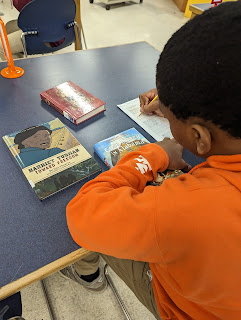Recently, I spoke with a
teacher about young people and their reading habits. The teacher believed
that young people don't like to read. A common misperception, I quickly
shared that based on my experience most young people don't enjoy reading
because they don't have choice and access. I shared some of my
experiences with undiscovered readers and suggested he give Book Matching a try.
He agreed and we set up a time for the students to receive the survey and
selected days for the class visits to the library.
The class visits were a chance for me to meet the students and lead them through the surveys. During the visits, I shared the background of Book Matching and the connection to an upcoming
assignment. Most students were interested to hear book suggestions would be
made based on their interests. There were also a few students who were
nonplussed and uninterested. I assured them that they would enjoy the process.
The first set of surveys was completed.
Due to a glitch, the
second set of surveys was not completed. Based on the time necessary to review
surveys and select three to four titles for each student, Mr. Giles and I
revamped the focus of the class visit and morphed it into a thematic Book
Tasting.
A first for me, I pulled
a variety of nonfiction and fiction titles related to the theme and topic of
resistance. From graphic novels depicting the American Revolution to
historical fiction set in WWII, numerous genres and formats were selected. Each
place setting included three titles: a nonfiction title, a fiction title, and a
graphic novel, comic, or manga. The three books were placed on the tables in
the library as place settings.
The first day of classes
began with students discussing their ideas of
what a book tasting might be. Some students mentioned "trying out new
books" and others shared that they would have a chance to look at books to
see what they liked. I then shared the purpose of the Book Tasting. Mr. Giles
shared the why. Next, I discussed the process and modeled for the students ways to use a variety of pre-reading strategies to "taste" the books and the first round of Book Tasting began.
After two to three
rounds, students were able to check out books that they had listed as their top
picks. By the end of the day, 65 books had been checked out by the two
classes. I decided to revise the lesson one more time.
For the second day of
lessons, students didn't receive a worksheet. Instead, students were asked to
place their favorite books to the right, their least favorite books to the
left, and any other book in the middle. After the first round, students were able
to take their top picks with them as they "tasted" other titles. By the time
the class had completed three to four rounds, many students had at least one
book selected to check out. By the end of the day, we
had 36 students who had checked out 41 books.
Two things were
observable, the students enjoyed the visit and were excited to get books.
Second, nearly half of the students were visiting the library for the first
time in nearly two years. *
The enjoyment was
apparent the next day when two students stopped by the library to check out
more books.
Based on this
experience, this reset of Book Tasting will be shared with more classroom
teachers to connect curricular requirements and infuse the joy of
reading.
Stay tuned for more
updates.
* See my previous
blog, Reset Time: Part One, for
more details.














No comments:
Post a Comment